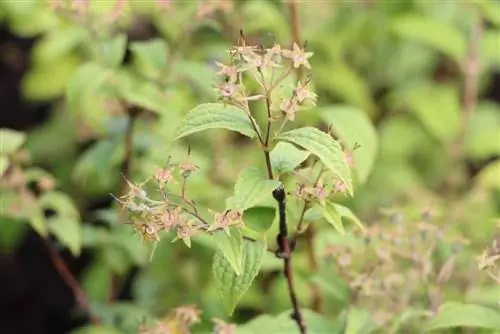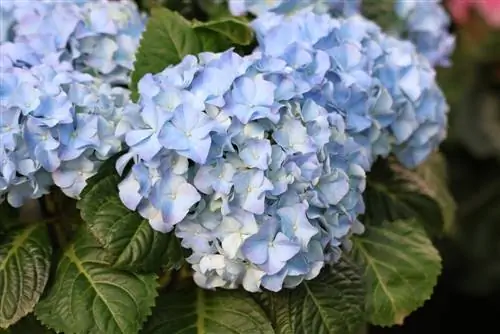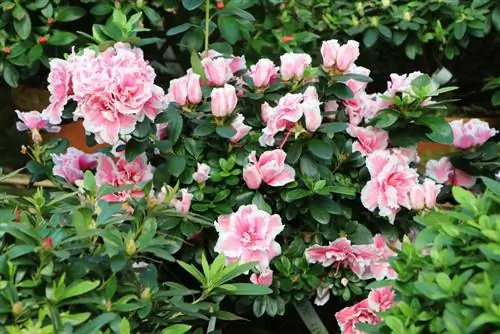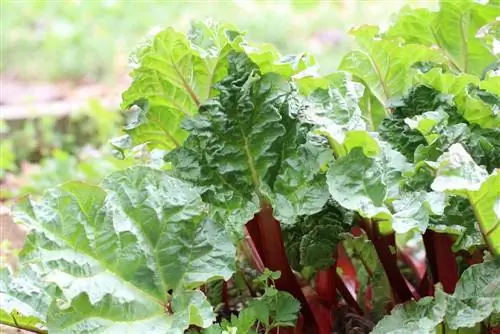- Author admin [email protected].
- Public 2023-12-17 03:39.
- Last modified 2025-01-24 12:45.
The growth of a Deutzia is characterized by a tightly upright silhouette made up of numerous basic shoots. These are usually arranged like a clump and lean over a little elegantly during the flowering period. With annual growth of between 10 and 50 cm, coupled with sparse branching, the May flower bush tends to age.
That doesn't have to be the case, because with an uncomplicated shape and maintenance pruning, the opulent flowering tree stays young, vital and happy to bloom. If you want to do everything right, divide the pruning into 2 stages. This guide explains in a clear and practical way when and how to skilfully cut your Rose Deutzia.
The cutting date is twice a year
As a spring bloomer, the Deutzia lays its buds in the summer for the next flowering period. In order to cut the flowering bush into shape, the classic date for pruning the tree in late winter is not an option. Anyone who attacks the branches with scissors at this point will also remove numerous buds. In order to regulate the longitudinal growth of young branches, an appointment at the end of the flowering period is ideal. An overcast day in July works best.
The dense foliage in early summer, on the other hand, prevents professional pruning for maintenance pruning because the view into the interior of the bush is blocked. In order to protect the ornamental shrub from aging, the focus is on a day during the leafless period. The second stage of pruning takes place on a frost-free day between January and March.
Instructions for topiary
In the first 3 years, a Deutzia can be given free rein to grow so that it can develop its natural, beautiful, harmonious habitus undisturbed. During this time, summer pruning is limited to cleaning out withered flowers. Then cut the bush like this:
- Short shoots growing out of shape by a maximum of half
- Make the cut a short distance from a pair of leaves or a sleeping eye
- Cut out wilted flowers on all other branches down to the nearest pair of leaves
Depending on the growth rate of your Deutzia variety, a topiary is not necessary every year. While a tall May flower bush (Deutzia magnifica) has up to 50 cm annual growth, a low star bush (Deutzia rosea) limits itself to a modest 10 cm. This is particularly true for May flower bushes in a pot or as a solitary plant in a bed. If the bushes form into a flowering hedge, the well-groomed appearance is maintained until autumn after a slight pruning in July.
Tip:
Deutzia are part of the hydrangea family and are therefore not poisonous. However, the leaves and flowers are not suitable for consumption. Please dispose of the clippings in the compost and do not use them as green fodder for animals.
Instructions for the maintenance cut
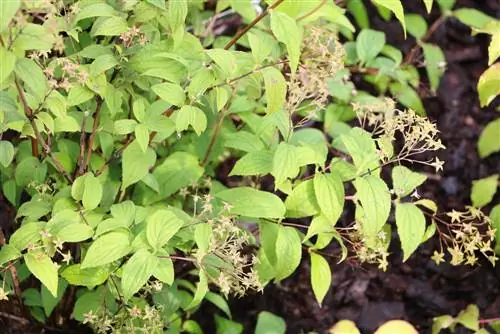
The second stage in pruning a Deutzia aims to preserve the flowering shrub's youthful flowering and to prevent baldness from the inside out. What is typical for all Deutzia species and varieties is that the branches produce less growth as they get older. The number of buds and flowers is reduced accordingly. At the same time, the growth in thickness continues unabated, so that hardly any light reaches the interior of the bush. Therefore, neither shoots nor leaves thrive here, so aging progresses from year to year. You can counteract this process in late winter with the following cut:
- Cut off all dead shoots close to the ground
- Short older branches with poor growth at the tip to 20 cm
- Remove one of the basal shoots that are too close together
- Cut off any branches that grow out of the shape at the side except for a stub
By leaving a remnant of 10 to 20 cm from over-aged branches, a fresh shoot can develop from the sleeping eyes. Sleeping eyes are leaf buds that rest under the bark and are vitalized as a result of being cut at a short distance. If the base shoots are too close together, are you faced with the choice of which one to remove? Then the older shoot should give way, even if a younger shoot appears to be weaker.
A perfectly executed maintenance cut leaves a bush flooded with light so that the sun allows new leaves to grow close to the ground. Furthermore, at first glance you can't tell that a Deutzia has been cut back.
Tip:
Organic fertilization with compost and horn shavings stimulates the growth of a Deutzia after maintenance pruning. To do this, the fertilizer material is raked in on the surface and sprayed with water or nettle manure.
Instructions for the rejuvenation cut
If no maintenance pruning is carried out for several years, a rose deutzia is bare on the inside and only blooms on a few shoot tips. Instead of clearing the valuable ornamental tree, a rejuvenating cut can breathe new life into the May flower bush. With a little patience and this approach, the plan can succeed:
- The best time is in late winter from January to March
- First cut off all completely dead shoots close to the ground
- Short the remaining branches down to 20 cm, or 2 sleeping eyes
After this radical pruning, the ornamental shrub will not bloom for the next one to two years. During this phase, a new basic structure is built up, which is maintained according to these instructions with regular shape and maintenance pruning.
Continuous rejuvenation instead of radical cuts
A Deutzia should only be cut off to short stubs in an emergency. By combining maintenance pruning with continuous rejuvenation, you can effectively prevent radical pruning or clearing. The cut follows a simple strategy:
- The starting shot is given between the third and fifth year
- In addition to maintenance pruning, cut off the two oldest basic shoots close to the ground every 2 years
- Remove these branches even if they are not completely dead
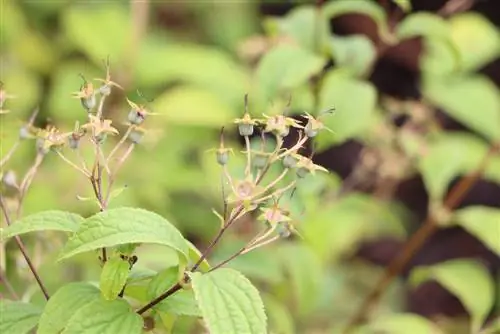
By following a continuous rejuvenation approach, you don't wait for over-aged wood to go bald. Rather, you create space in good time for new basal shoots to sprout directly from the root disk.
Tips for the right cutting tool
Pruning and cutting pattern go hand in hand for the professional pruning of a Deutzia. The sophisticated approach comes to nothing if unsuitable tools leave frayed and damaged wood. Choosing the right equipment makes an important contribution to ensuring that cutting mature May flower bushes does not require unnecessary effort. Specialist retailers differentiate between bypass and anvil scissors, each with their own individual advantages. The following tips show what you should pay attention to when buying scissors and saws:
Bypass scissors
One-handed bypass scissors have two sharp blades. The design ensures that a shoot is cut through smoothly. In this way, frayed cuts cannot be created, which pathogens and pests can use as a target. Since this technique requires more effort, it is primarily suitable for cutting young to semi-woody shoots up to 18 mm thick or for cleaning out withered flowers. Bypass scissors are available for right- and left-handed people, which allows for individual handling.
Anvil Scissors
One-handed anvil pruners work on the concept that the branch is pressed onto a straight plastic surface so that the sharp side of the blade makes the cut. The advantage of this design is better power transmission, which noticeably reduces the gardener's energy expenditure. Some models have an integrated ratchet function, which also allows thicker base shoots up to 25 mm to be cut effortlessly. What is seen as a disadvantage is that the wood could be crushed with cheap products. When purchasing, pay attention to whether it is a model for right-handed or left-handed people.
Pruning Shears
Investing in pruning shears for pruning a Deutzia is only worthwhile if you are dealing with branches between 30 and 55 mm. Such scissors are used with both hands and are available as both bypass and anvil scissors. To cut one or two strong shoots, a hand saw does the job just as well and is cheaper to purchase.
Handsaw
A sturdy hand saw should not be missing from the hobby gardener's standard equipment when all kinds of trees are cultivated in the garden. If a starlet bush gets old, a thick basal shoot can be thinned out in no time with the right saw. A length between 12 and 16 mm is recommended for the saw blade. Coarse teeth reduce the effort required. It is important to note that the handle has a non-slip surface. Ideally, the saw blade can be retracted into the handle.
Conclusion
A regular pruning in two stages is crucial for a blooming Deutzia. Otherwise, the densely branched flowering shrub will tend to age over time, which will affect its picturesque spring blossoms. Topiary pruning is available if necessary by shortening branches that are too long at the end of the flowering period. In contrast, maintenance pruning is essential from the third to fifth year onwards. Dead shoots are cut close to the ground and overaged branches are cut down to 20 cm. The best time for pruning is during the leafless period at the end of winter, in time for new growth. As a continuous rejuvenation treatment, ideally you should also thin out the two oldest basic shoots at 2-year intervals.

